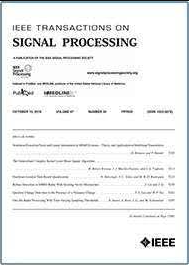A Bayesian sampling approach to decision fusion using hierarchical models
A generic framework for blind source separation in structured nonlinear models
Regularity and strict identifiability in MIMO systems
Maximum-likelihood source localization and unknown sensor location estimation for wideband signals in the near-field
A frequency domain blind signal separation method based on decorrelation
Adaptive instantaneous frequency estimation of multicomponent FM signals using quadratic time-frequency distributions
Local echo canceler with optimal input for true full-duplex speech scrambling system
Exploiting sparsity in adaptive filters
Wiener design of adaptation algorithms with time-invariant gains
Recursive estimation of the covariance matrix of a compound-Gaussian process and its application to adaptive CFAR detection
Cramer-Rao bound for nonlinear filtering with Pd<1 and its application to target tracking
Fast recursive basis function estimators for identification of time-varying processes
A polynomial-time algorithm for designing FIR filters with power-of-two coefficients
A robust O(N log n) algorithm for optimal decoding of first-order /spl Sigma/-/spl Delta/ sequences
Two's complement quantization in periodic digital filters
Signal extrapolation in the real Zak space
Generalized sampling: a variational approach .I. Theory
Generalized sampling: a variational approach .II. Applications
Scale-invariant nonlinear digital filters
Fast principal component extraction by a weighted information criterion
Automating the modeling and optimization of the performance of signal transforms
Asymptotic performance of subspace methods for synchronous multirate CDMA systems
Structured semi-blind interference rejection in dispersive multichannel systems
Pilot-based estimation of time-varying multipath channels for coherent CDMA receivers
Three-dimensional discrete wavelet transform architectures
Multidimensional synchronous dataflow
Disentangling chromosome overlaps by combining trainable shape models with classification evidence

